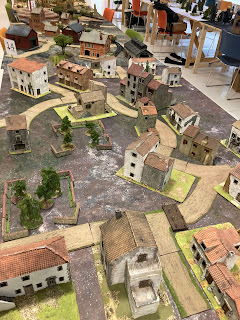Extract from New Age Comics 2 (1937)
Tomb of the Serpent
This is the second instalment of my Tomb of the Serpent campaign. After their adventures in Italy, our team from the Mace Institute sailed from Brindisi to Alexandria, where they travelled to the British Archaeological Society's (BAS) mansion on the outskirts of Cairo. Here the team found a package of papers waiting for them with the help of local experts from BAS; their mission turned to hunt down three artefacts from the Hyksos period that would help them locate the tomb of Apophis.
Not far from the BAS's colonial mansion was an archaeological dig led by the French School that had uncovered structures from the Hyksos period, including several tombs. To this site, our intrepid team now go, searching for its buried secrets.
The Dig
The excavations were about fifteen miles from the centre of Cairo. The journey there was hot and dusty, with clouds of sand being dislodged by the small convoy of cars. Not wishing to announce their arrival, Sir Frances ordered the vehicles left in a small hollow a half hour's walk from the archaeologist’s camp. Our adventurers approach the site from the rocky high ground from the east. Standing on a rocky outcrop, our heroes could see the location below. The camp was quiet, with a couple of men walking around the bases, tidying things up and preparing some food for the evening meal. Archaeologists huddled around a trench on the hill to the north, seemingly discussing its contents. Further in the distance, shapes could be seen near the main tomb entrance. However, it was impossible to work out what they were because they were in the shadow of the tomb.Plans of Mice and Men
Initially, the team decided to stay together due to their experiences in Italy. However, this plan was soon abandoned because they needed to cover the site before sunset. Therefore, Slade, Sir Francis and Daphne found themselves in the camp, trying to obtain information from the Arab servants.Still, as Daphne was examining the tents, some figures near the tomb began to run in her direction. A feeling of dread descended on her as the sickly smell of death and decay also emanated from that direction.
Meanwhile, Honey, Thwaites, and Archie had climbed the small hill to interrogate the archaeologist, only to be met with a Gaelic shrunk and told they had no business to be on the site. As all seemed lost when a French archaeologist recognised Thwaites from the war, the conversation suddenly became more amenable, and they got permission to examine some pots. However, as success was possibly in their grasp, Archie spotted several men running towards them with swords drawn. Archie let off a few shots but to little avail, as he told Honey to speed up her search.
Pots, Shots and Scorpions
As Archie’s shots echoed across the valley, several shambling creatures had entered the camp, only to be met by several rounds from Sir Francis’ trusted old Welby. The dig site was now the site of several minor skirmishes. Honey and Thwaites seem stuck on the hill fighting off some cultists. Unlucky, Alfie was stung by a scorpion hiding in one of the pots and was now out of the game. Meanwhile, the undead creatures that had entered the camp were now joined by a living mummy, whom Slade was having difficulty containing.Only Daphne and Sir Francis continued searching for the clue as they had managed to eliminate the undead horde, but the light was deteriorating. Finally, Sir Francis entered one of the tents and discovered the lead archaeologist hiding behind some storage jars, fearing for his life. The archaeologist shaking and wanting it all to stop, pointed to some papyrus scrolls and artefacts.
‘Take them’, he screamed, ‘just get these creatures away from me’.
The team started a fighting retreat with the artefacts in the procession. As the shadows deepened and lengthened, the group finally returned to their transport. As they began to pull away, they could hear a strange hissing sound, almost musical, coming from the tomb, and suddenly, the valley and the dig site were silent. Not even the sound of a bird could be heard.
Adventures in Cairo Continue
What was the mysterious artefact? Why is the fabric between the dead and the living disintegrating, and will the unlucky Alfie survive the scorpion's sting?





















